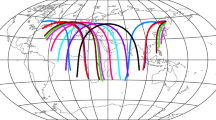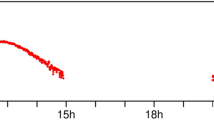Abstract
GPS satellites of Block IIR-M and the subsequent Blocks have the capability to redistribute the transmit power of the individual signal components, which is called flex power. This technology is used to prevent enemy jamming by increasing the power of the designed signal. It is of great importance to detect flex power since it has great impacts on differential code biases, phase shifts, and multiple access interference. Based on geodetic stations, stepwise enhancement in their carrier-to-noise density ratios (C/N0) can reflect the power changes caused by flex power. Thus, we propose a real-time detection method for GPS flex power based on C/N0 patterns. The patterns for 100 International GNSS Service stations uniformly distributed around the world are built according to their azimuths and elevations. In order to evaluate the performance of the proposed method, daily data with 30-s sampling in 2020 and real-time data with 1-s sampling in 2023 are adopted to detect flex power with the new method. Results of experiment show that the average false positive rate for real-time detection is around 10–6, and the true positive rate is 0.999479. The results confirm the effectiveness of our method for real-time flex power detection. Meanwhile, a new flex power mode is discovered in real-time detection experiments, which has the largest coverage area between longitudes 125°W and 180°E.

















Similar content being viewed by others
Data availability
The datasets generated during and/or analyzed during the current study are available in the repository [http://gdc.cddis.eosdis.nasa.gov/pub/gnss/data/daily].
References
Barbour B (2011) Global positioning system status. 2D SPACE OPERATIONS SQUADRON SCHRIEVER AFB CO. https://www.gps.gov/cgsic/international/2009/stockholm/barbour.pdf
Berstis KA (2010) Technologies of Interest to Surveyors in 2025. https://www.gps.gov/multimedia/presentations/2010/10/TSPS/berstis3a.pdf
Esenbuğa ÖG, Hauschild A (2020) Impact of flex power on GPS Block IIF differential code biases. GPS Solut 24(4):91. https://doi.org/10.1007/s10291-020-00996-x
Esenbuğa ÖG, Hauschild A, Steigenberger P (2023) Recent flex power changes. GPS Solut 27(3):104. https://doi.org/10.1007/s10291-023-01415-7
Falletti E, Pini M, Presti LL (2011) Low complexity carrier-to-noise ratio estimators for GNSS digital receivers. IEEE Trans Aerosp Electron Syst 47(1):420–437. https://doi.org/10.1109/TAES.2011.5705684
Fan J, Li C, Yuan L, Niu F (2012) Study on Power-Enhanced Technology of Global Navigation Satellites. In: Sun J, Liu J, Yang Y, Fan S (eds) China Satellite Navigation Conference (CSNC) 2012 Proceedings. Springer, Berlin, Heidelberg, pp 77–83. https://doi.org/10.1007/978-3-642-29193-7_7
International GNSS Service (IGS) RINEX Working Group and Radio Technical Commission for Maritime Services Special Committee 104 (RTCM-SC104) (2021) RINEX, the receiver independent exchange format, Version 4.00. http://igs.org/pub/data/format/rinex400.pdf. Accessed 20 Apr 2023
IS-GPS-200J (2018) Interface specification IS-GPS-200: Navstar GPS space segment/ navigation user segment interfaces. https://www.gps.gov/technical/icwg/IS-GPS-200J.pdf
IS-GPS-200N (2022) Interface specification IS-GPS-200: Navstar GPS space segment/ navigation user segment interfaces. https://www.gps.gov/technical/icwg/IS-GPS-200N.pdf
IS-GPS-705J (2022) Interface specification IS-GPS-075: Navstar GPS space segment/ navigation user segment interfaces. https://www.gps.gov/technical/icwg/IS-GPS-705J.pdf
IS-GPS-800J (2022) Interface specification IS-GPS-800: Navstar GPS space segment/ navigation user segment interfaces. https://www.gps.gov/technical/icwg/IS-GPS-800J.pdf
Jimenez-Banos D, Perello-Gisbert J, Crisci M (2010) The measured effects of GPS Flex power capability collected on sensor station data. In: 2010 5th ESA workshop on satellite navigation technologies and European workshop on GNSS signals and signal processing (NAVITEC). https://doi.org/10.1109/NAVITEC.2010.5708073
Otsu N (1979) A Threshold Selection Method from Gray-Level Histograms. IEEE Trans Syst Man Cybern 9(1):62–66. https://doi.org/10.1109/TSMC.1979.4310076
Steigenberger P, Thölert S, Montenbruck O (2019) Flex power on GPS Block IIR-M and IIF. GPS Solut 23(1):8. https://doi.org/10.1007/s10291-018-0797-8
Steigenberger P, Thölert S, Esenbuğa ÖG, Hauschild A, Montenbruck O (2020) The new flex power mode: from GPS IIR-M and IIF satellites with extended coverage area. Inside GNSS 15:52–56
Thoelert S, Hauschild A, Steigenberger P, Langley R, Antreich F (2018) GPS IIR-M L1 transmit power redistribution: analysis of GNSS receiver and high-gain antenna data. J Inst Navig. https://doi.org/10.1002/navi.250
Woo K (2000) Optimum semicodeless carrier-phase tracking of L2. J Inst Navig 47(2):82–99. https://doi.org/10.1002/j.2161-4296.2000.tb00204.x
Wübbena G, Schmitz M, Bagge A (2012) Additional Thoughts and Findings on Satellite Induced GNSS Phase Shifts, Receiver Tracking and the Impact on RINEX and RTCM. http://www.geopp.com/pdf/geopp_phase_shift_survey.pdf
Yang X, Liu W, Huang J, Xiao W, Wang F (2022) Real-time monitoring of GPS flex power based on machine learning. GPS Solut 26(3):73. https://doi.org/10.1007/s10291-022-01257-9
Acknowledgements
We would like to thank the GNSS center of CDDIS (http://gdc.cddis.eosdis.nasa.gov/pub/gnss/) and iGMAS (http://www.igmas.org/Product/TreePage/tree/cate_id/37.html) for providing the raw GNSS data.
Funding
This work is supported by the National Natural Science Funds of China (42104013, 42225401), the Fundamental Research Funds for the Central Universities, Natural Science Funds of Shanghai (21ZR1465600), the Innovation Program of Shanghai Municipal Education Commission (2021–01-07–00-07-E00095), and the Scientific and Technological Innovation Plan from Shanghai Science and Technology Committee (22511103003).
Author information
Authors and Affiliations
Contributions
GM proposed the idea and designed and conducted the experiments; GM and HG analyzed the data, prepared the figures, and wrote the manuscript; HG and BL supervised the project and revised the manuscript. All authors joined discussions throughout the development and reviewed the manuscript.
Corresponding author
Ethics declarations
Competing interests
The authors declare no conflict of interest.
Ethics approval
Not applicable.
Consent for publication
The biographical information and photographs were provided by each author individually for publication.
Additional information
Publisher's Note
Springer Nature remains neutral with regard to jurisdictional claims in published maps and institutional affiliations.
Rights and permissions
Springer Nature or its licensor (e.g. a society or other partner) holds exclusive rights to this article under a publishing agreement with the author(s) or other rightsholder(s); author self-archiving of the accepted manuscript version of this article is solely governed by the terms of such publishing agreement and applicable law.
About this article
Cite this article
Meng, G., Ge, H. & Li, B. A real-time detection method for GPS flex power. GPS Solut 28, 111 (2024). https://doi.org/10.1007/s10291-024-01653-3
Received:
Accepted:
Published:
DOI: https://doi.org/10.1007/s10291-024-01653-3




